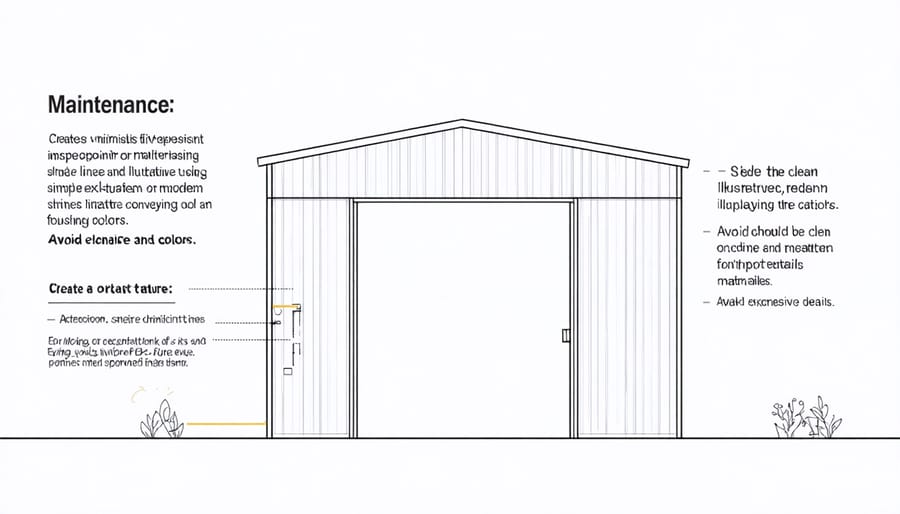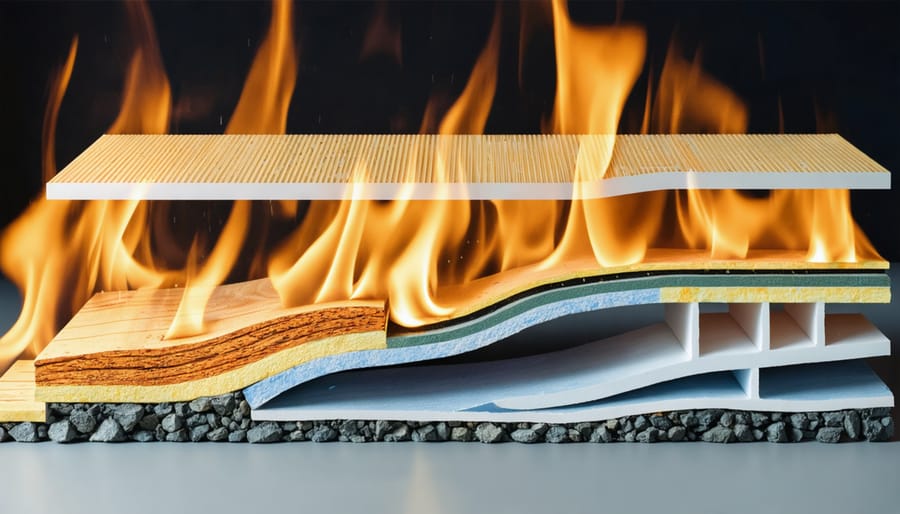Fire-resistant materials have revolutionized modern construction, offering unprecedented protection against one of nature’s most destructive forces. From innovative ceramic composites to advanced mineral-based panels, these materials form the cornerstone of contemporary fire safety strategies in both residential and commercial buildings.
When selecting fire-resistant materials for your shed or storage structure, understanding their capabilities becomes crucial. Not all fire-resistant materials offer equal protection – some excel at containing flames, while others specialize in maintaining structural integrity under extreme heat. This distinction can mean the difference between minor damage and catastrophic loss during a fire event.
Recent advancements in material science have introduced a new generation of fire-resistant options that combine superior protection with practical functionality. These materials not only meet stringent safety standards but also offer additional benefits like weather resistance, durability, and aesthetic appeal. From intumescent coatings that expand under heat to create protective barriers, to specially engineered composite panels that maintain their strength at high temperatures, today’s fire-resistant materials provide homeowners with versatile solutions for protecting their valuable assets.
Understanding these innovations empowers property owners to make informed decisions about protecting their investments while ensuring compliance with local building codes and safety regulations.

Top Fire-Resistant Materials for Shed Construction
Metal and Steel Options
When it comes to fire-resistant materials, metal storage solutions lead the pack in both safety and durability. Steel panels and frames offer exceptional fire resistance, with many options rated for up to three hours of direct fire exposure. Common choices include galvanized steel panels, which combine fire protection with rust resistance, and structural steel frames that maintain their integrity even under intense heat.
For optimal protection, consider commercial-grade steel panels with a minimum thickness of 26 gauge. These panels often feature specialized coatings that enhance their fire-resistant properties while adding an attractive finish. Corrugated steel panels are particularly popular, as their design provides additional structural strength without compromising fire safety.
Stainless steel components offer another excellent option, especially for areas prone to moisture exposure. While slightly more expensive than standard steel, stainless steel’s corrosion resistance ensures long-term durability alongside its fire-resistant properties. Many homeowners appreciate that these materials require minimal maintenance while providing peace of mind in terms of fire safety.
Remember to check local building codes, as they may specify minimum metal thickness and coating requirements for fire-resistant structures.
Fire-Rated Composite Materials
Modern composite materials have revolutionized fire-resistant construction by combining the best properties of multiple components. These innovative materials, which often complement other weather-resistant materials, offer exceptional fire protection while maintaining structural integrity and aesthetic appeal.
Popular fire-rated composites include fiber-reinforced polymers (FRP) panels, which blend glass fibers with fire-retardant resins. These lightweight yet durable panels provide excellent fire resistance while being easier to install than traditional materials. Another breakthrough is mineral-core aluminum composite panels, which sandwich a non-combustible mineral core between aluminum sheets.
For shed applications, composite deck boards and siding materials that incorporate fire-resistant minerals and polymers are particularly valuable. These materials often feature a wood-like appearance while offering superior fire protection. Many newer composites also include intumescent properties, meaning they expand when exposed to heat, creating an insulating barrier that protects the structure underneath.
What makes these materials especially practical for homeowners is their dual functionality – they’re not just fire-resistant but also durable, low-maintenance, and visually appealing.
Treated Wood and Fire-Resistant Coatings
Fire-retardant treated wood offers excellent protection for your shed while maintaining a natural appearance. This specially processed lumber undergoes pressure treatment with fire-resistant chemicals that penetrate deep into the wood fibers, making it significantly more resistant to flames. When selecting treated wood, look for products labeled with a “Class A” fire rating for optimal protection.
Protective coatings provide an additional layer of fire resistance for both new and existing structures. Intumescent paints and clear coatings expand when exposed to heat, creating an insulating barrier that shields the underlying material. These coatings are particularly effective on wooden surfaces and can be refreshed periodically to maintain their protective properties.
For best results, combine treated wood with fire-resistant coatings, especially in high-risk areas. Remember to reapply coatings according to manufacturer guidelines, typically every 5-7 years, to ensure continued protection.
Critical Components for Fire Protection
Roofing Materials
When it comes to protecting your shed from fire hazards, choosing the right roofing material is crucial. Class A fire-rated materials offer the highest level of protection, with metal roofing leading the pack. For those interested in metal roofing installation, steel and aluminum panels provide excellent fire resistance while offering durability and style.
Concrete or clay tiles are another fantastic option, naturally resistant to fire and capable of withstanding extreme temperatures. While they’re heavier than other materials, their longevity and protective qualities make them worth considering for areas prone to wildfires.
Composite shingles with a Class A rating combine affordability with fire protection. Look for products featuring mineral granules and fiberglass mat cores, which enhance their fire-resistant properties. These materials often come with warranties of 30 years or more, making them a smart long-term investment.
For maximum protection, consider installing a fire-resistant underlayment beneath your chosen roofing material. This additional layer creates a robust barrier against flying embers and radiant heat, significantly improving your shed’s overall fire resistance.

Wall Construction
When constructing fire-resistant walls, layering different materials creates the most effective protection for your shed. Start with fire-rated gypsum board (Type X drywall) as your interior wall surface, which provides up to one hour of fire resistance. Install the boards horizontally and ensure all seams are properly taped and mudded for maximum effectiveness.
Behind the drywall, consider using mineral wool insulation, which not only improves fire resistance but also offers excellent soundproofing properties. This naturally fire-resistant material doesn’t melt until temperatures exceed 2000°F, giving you valuable time in case of fire.
For exterior walls, cement board or fiber cement siding provides an excellent fire-resistant barrier. These materials are particularly effective because they’re non-combustible and can withstand direct flame exposure. Make sure to include a fire-resistant barrier beneath the siding, such as a mineral-based weather barrier.
Pay special attention to joints and corners, as these are potential weak points in your fire-resistant assembly. Use fire-rated caulk to seal any gaps or joints between materials. When installing electrical outlets or other wall penetrations, use fire-rated boxes and ensure they’re properly sealed.
Remember to check local building codes, as they may require specific fire-rated assemblies depending on your shed’s location and intended use. Regular inspection of your wall assembly ensures continued fire resistance and early detection of any compromised areas.
Doors and Ventilation
Fire-resistant doors and proper ventilation are crucial components in creating a safer storage environment. When selecting doors, opt for metal options rated for at least 45 minutes of fire resistance. Steel doors with intumescent seals are particularly effective, expanding when exposed to heat to block smoke and flames. For added protection, consider installing self-closing mechanisms that automatically shut doors during emergencies.
Ventilation requires careful consideration to balance fire safety with proper airflow. Fire-rated vents equipped with automatic dampers can help prevent flame spread while maintaining necessary air circulation. These dampers close when detecting excessive heat, creating a barrier against fire progression. Position vents strategically near the roof and base of your structure to encourage natural airflow while maintaining structural integrity.
Remember to check your local building codes, as requirements for fire-rated doors and ventilation systems vary by region. Regular maintenance of door hinges, seals, and vent mechanisms ensures they’ll function properly when needed. Consider installing smoke detectors near ventilation points for early warning of potential issues.
Installation and Maintenance Tips
Professional Installation vs. DIY
When it comes to installing fire-resistant materials, homeowners often face the choice between professional installation and DIY approaches. While DIY installation can save money, professional installation offers expertise and peace of mind, especially when dealing with critical safety features.
Professional installers bring specialized knowledge of building codes, proper material handling, and installation techniques. They understand the nuances of different fire-resistant materials and can ensure proper placement and sealing. This expertise is particularly valuable when installing complex systems like fire-rated drywall or intumescent coatings, where precise application is crucial for effectiveness.
However, many fire-resistant materials are DIY-friendly, especially for those with basic home improvement skills. Materials like fire-resistant caulk, weather stripping, and simple panel installations can be managed by most homeowners. The key is thoroughly researching installation requirements and following manufacturer guidelines precisely.
Before deciding, consider these factors:
– Project complexity and scale
– Local building codes and permit requirements
– Your comfort level with construction tasks
– Time availability
– Budget constraints
– Insurance requirements
For critical areas or large-scale projects, professional installation is recommended. However, smaller protective measures can often be successfully completed as DIY projects. Whatever route you choose, always prioritize proper installation to ensure maximum fire resistance effectiveness.
Remember, some manufacturers may require professional installation to maintain warranty coverage, so check documentation carefully before proceeding with DIY installation.
Long-term Maintenance Requirements
Regular inspection and proper maintenance are crucial for ensuring your fire-resistant materials continue to provide optimal protection. The long-term maintenance requirements typically include quarterly visual inspections of all surfaces for signs of wear, damage, or deterioration.
Check for any cracks, gaps, or separations in fire-resistant coatings or materials at least every three months. Pay special attention to areas around doors, windows, and other openings where seals might deteriorate over time. Clean surfaces regularly using manufacturer-recommended products to prevent the buildup of debris that could compromise fire resistance.
For intumescent coatings, inspect the thickness annually to ensure it hasn’t worn down below recommended levels. Keep detailed records of all inspections and maintenance work performed, including dates and specific areas addressed. This documentation can be valuable for insurance purposes and future reference.
If you notice any damage, address it promptly to maintain the material’s fire-resistant properties. Small repairs should be handled using manufacturer-approved materials and methods. For significant damage or deterioration, consult a professional who specializes in fire-resistant materials.
Remember to test fire alarms and sprinkler systems regularly as part of your overall fire safety maintenance routine. By following these maintenance guidelines, you’ll help ensure your fire-resistant materials provide reliable protection for years to come.

Throughout this exploration of fire-resistant materials, we’ve discovered how crucial these protective elements are in safeguarding our storage spaces and valuable possessions. The right choice of fire-resistant materials not only provides peace of mind but also adds significant value to your property while potentially reducing insurance costs.
Remember that fire resistance isn’t just about meeting building codes – it’s about creating a safer environment for you and your community. Whether you’ve opted for cement fiber boards, treated lumber, or metal components, each material plays a vital role in slowing or preventing fire spread. The initial investment in quality fire-resistant materials may seem substantial, but it’s a small price to pay compared to the potential loss of property or, worse, life.
When selecting materials for your storage structure, consider the complete picture: fire rating, durability, maintenance requirements, and local climate conditions. The best choices often combine multiple benefits – like metal roofing that offers both fire resistance and weather protection, or cement-based siding that provides durability alongside fire safety.
Don’t forget that proper installation is just as important as material selection. Even the most fire-resistant materials can fail if not installed correctly. Working with qualified professionals or following manufacturer guidelines precisely when doing it yourself is essential for achieving maximum fire protection.
Regular maintenance and inspection of your fire-resistant materials ensure their continued effectiveness. Watch for signs of wear, damage, or deterioration that could compromise their protective properties. Keep surrounding areas clear of flammable debris and maintain proper ventilation to enhance the overall fire safety of your structure.
By choosing appropriate fire-resistant materials and maintaining them properly, you’re not just protecting your property – you’re investing in safety and peace of mind for years to come. Take the time to research your options, understand local requirements, and implement the best solutions for your specific needs.





Leave a Reply